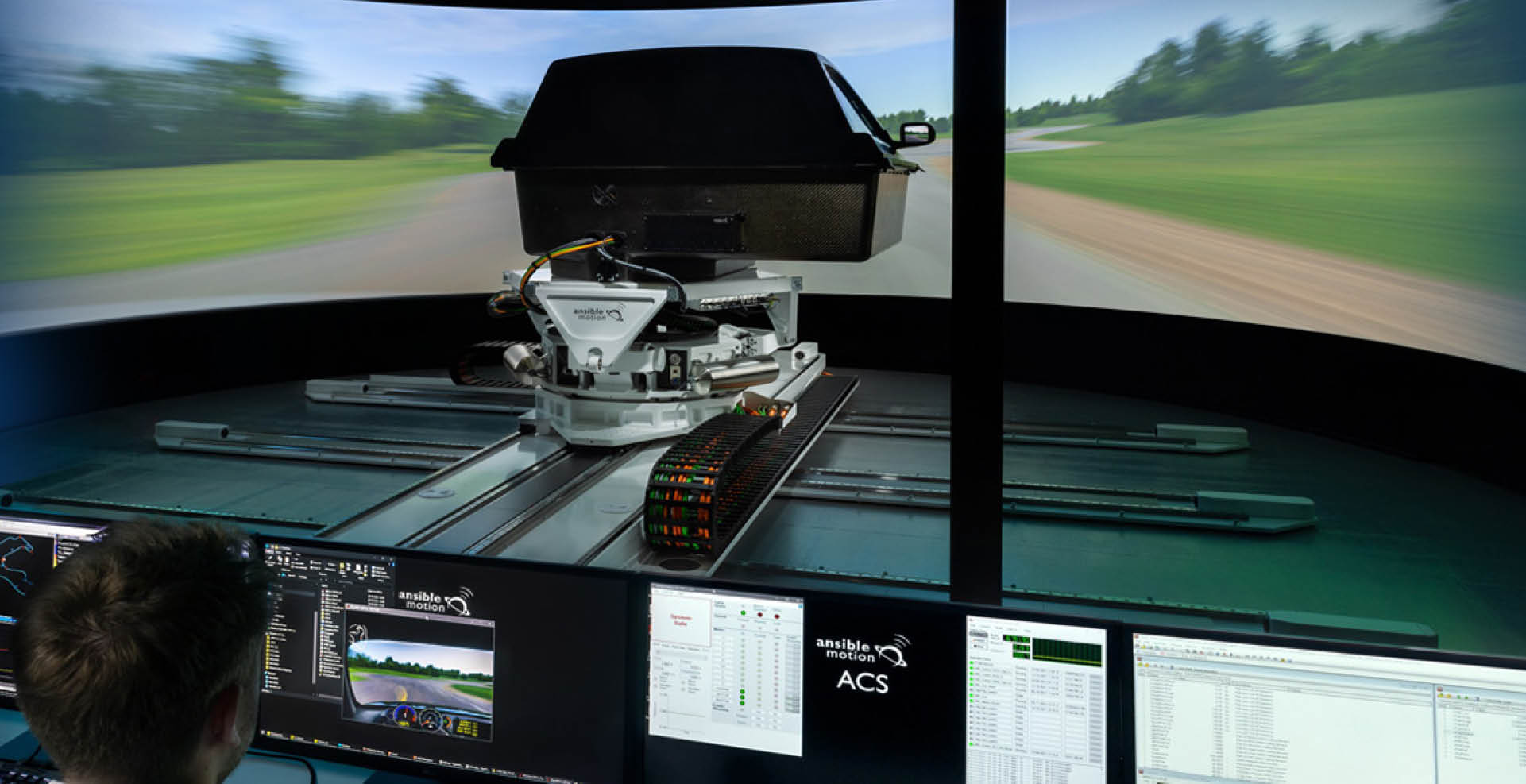Ansible Motion have been developing driver-in-the-loop simulation technologies for over a decade and are integrating our own Pi Toolbox and Diablo software packages into many of their products to solve challenges and streamline the data analysis connection between virtual and real-world testing.

Overview
Over the last two decades an increasing number of race teams have invested in using driver-in-loop simulation as a tool to develop their competition cars. This has been driven by several factors including stricter regulations from governing bodies that limit the amount of testing taking place each year, and from a budget perspective. It is much more cost effective to run a car in a virtual space than having to ship an entire team which includes cars, tyres, parts, staff and other essential equipment to a racetrack hundreds (in some cases thousands) of miles away from their home facility.
Simulators offer teams the ability to test new parts, different setups, aero packages and almost every single part imaginable, all from within the confines of their factory. Testing can take place 24/7, if the means and staff are available – therefore in the modern era of racing, simulation is an extremely valuable development tool and essential if you want to be seriously competitive.
Driver-in-loop simulation is not only beneficial to racing, in recent years the technology has also spilled over to road vehicle development. Large scale OEMs are adopting the technology through their motorsport programmes, repurposing it and making it applicable to their road car projects. In some cases, the technology is now going back the other way with motorsport taking learnings from the automotive sector.
Ansible Motion have been developing driver-in-the-loop simulation technologies for over a decade and are integrating our own Pi Toolbox and Diablo software packages into many of their products to solve challenges and streamline the data analysis connection between virtual and real-world testing.
Challenges
Ansible Motion’s driving simulators are used primarily for creating virtual test drive experiences, so that real people can interact with existing and future automotive technologies. Drivers and experienced development engineers now require simulator-based experiences that are highly accurate at replicating what takes place in reality. Engineers need to acquire all the data that they would normally expect to acquire in a real test session. So, they need a fully instrumented virtual test vehicle in the simulator lab.
With Pi Toolbox, the telemetry orientation of the data gathering systems is ideal, because it allows Ansible to employ the same real time data monitoring and acquisition of everything that’s taking place, just like we would do with a real car except, this in a virtual environment.
In the virtual space, we need to communicate with vehicle physics models, which are just mathematical models of a vehicle operating in an environment. So, we have to establish an exchange data channel with a virtual model, just like we can with a real vehicle. The question here then becomes a matter of, how do we take that information back out and, what do we bring that in to? We know what data is available, but how do we bring all of the information to Toolbox in such a way that the operator, a data analyst, or engineer can read it? We do this by providing the data analyst with the same data signals that are acquired from a real vehicle that’s on a test track, with signals from a physics model that exists in a virtual space inside a lab.
Solutions
Really, this is where Diablo comes in. Kia Cammaerts, Technical Director of Ansible Motion has a lot of wind tunnel testing experience and was familiar with Diablo as a data server for real time telemetry in that environment.
There was a lightbulb moment within the team at Ansible Motion. They realised that if they’re trying to exchange a considerable volume of data with the virtual world – in an attempt to emulate real world conditions, and with Toolbox as the data analysis tool – Diablo could be the perfect data logger and telemetry server, with the added ability to pass control signals back to the simulator. This was indeed the case.
The real challenge to solve is the synchronisation. It’s highly convenient to have a data server managing multiple inputs from a mix of sources, computer physics models, real-world sensors and all the additional peripherals that Ansible Motion brings together inside a simulator lab.
For example, when acquiring video data at a specific frame rate, and trying to align it with data signals that are acquired at multi kilohertz, we need to bring the data streams together and synchronise them in order for them make sense to the end user. This is where we used our experience to add support for Toolbox Media Channels into Diablo, allowing synchronisation of simulated video streams. We brought disparate data acquisition sources into a common server field of awareness, and then delivered them in a way that is understandable. We assisted Ansible Motion with this challenge of bringing data together in Diablo, while presenting it as a simulation of real-world test experiences.
Customers of Ansible Motion that are using Pi Toolbox and Diablo as part of their simulation programmes include most of the top automobile manufacturers in the world – General Motors, Honda, BMW and many more.
Ian Haigh, Ansible Motion’s Sales Team Lead commented:
“The benefit in working with Cosworth has not just been about the technical details, but also the willingness to collaborate and help us help our customers. You’ve [Cosworth] been very open minded and have the deep technical knowledge required to solve customer issues. That experience enables you to understand what it is that we’re asking for very quickly. We’ve really appreciated this and are thankful for the continued collaboration.”